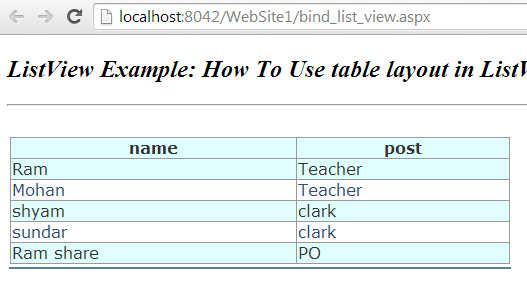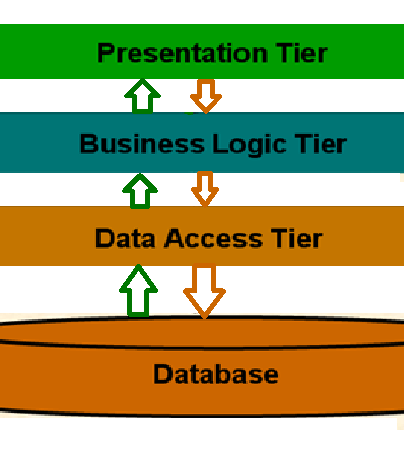Asp.net Query String with c# Example
Asp.net Query String :
In this post we see the QueryString technique of sending
data from one page two another pages. In the Internet, a querystring is
the part of a URL (uniform resource locator) which containing
data that does not fit conveniently into a hierarchical path structure. The
query string commonly includes data fields added to a base URI Part by a
browser or another client web application, for example as part of a HTML
form.
In this post we see the QueryString technique of sending data from one page two another pages. In the Internet, a querystring is the part of a URL (uniform resource locator) which containing data that does not fit conveniently into a hierarchical path structure. The query string commonly includes data fields added to a base URI Part by a browser or another client web application, for example as part of a HTML form.
Example of QueryString:
The Asp QueryString collection is used to get the variable
values in the Hypertext Transfer Protocol (refer to HTTP) query string. The
HTTP (Hypertext Transfer Protocol) query string is specified by the values , Here
we use the question mark (?) between asp.net web page and first asp.net query
string variable, like this:
<a href= "Mypage.asp?ID=1000 ">Link of query
string</a>
The line above generates a variable named ID with the value
"1000".
Query strings are also created by asp.net web form
submission.
Query String Syntax:
Request.QueryString(variable)[(index)]
Variable refers to ‘Required’ of the variable in the HTTP
query string to retrieve. And index is optional. That refers one of multiple
values for a Query String variable.
Advantages of QueryString
Advantages of QueryString
First Page of Query String in asp Example:
First Query String.aspx:
<%@ Page
Language="C#"
AutoEventWireup="true"
CodeFile="First
Query String.aspx.cs"
Inherits="First_Query_String"
%>
<!DOCTYPE html PUBLIC "-//W3C//DTD
XHTML 1.0 Transitional//EN" "http://www.w3.org/TR/xhtml1/DTD/xhtml1-transitional.dtd">
<html xmlns="http://www.w3.org/1999/xhtml">
<head id="Head1" runat="server">
<title>QueryString Example in asp.net</title>
</head>
<body>
<form id="form1" runat="server">
<div>
<b>Query String Example </b>
</div>
<br />
<div>
<table>
<tr>
<td>
<b>Id:</b>
</td>
<td>
<asp:TextBox ID="txtId" runat="server"
/>
</td>
</tr>
<tr>
<td>
<b>Name:</b>
</td>
<td>
<asp:TextBox ID="txtName"
runat="server"
/>
</td>
</tr>
<tr>
<td>
</td>
<td>
<asp:Button ID="btnok" Text="Send" runat="server"
OnClick="btnok_Click"
/>
</td>
</tr>
</table>
</div>
</form>
</body>
</html>
First Query String.aspx.cs page:
using System;
using System.Collections.Generic;
using System.Linq;
using System.Web;
using System.Web.UI;
using System.Web.UI.WebControls;
public partial class First_Query_String
: System.Web.UI.Page
{
protected void
Page_Load(object sender, EventArgs e)
{
}
protected void
btnok_Click(object sender, EventArgs e)
{
Response.Redirect("QueryString.aspx?UserId="
+ txtId.Text + "&UserName=" +
txtName.Text);
}
}
Query String in asp.net Example Second page code:
QueryString.aspx:
<%@ Page
Language="C#"
AutoEventWireup="true"
CodeFile="QueryString.aspx.cs"
Inherits="QueryString"
%>
<!DOCTYPE html PUBLIC "-//W3C//DTD
XHTML 1.0 Transitional//EN" "http://www.w3.org/TR/xhtml1/DTD/xhtml1-transitional.dtd">
<html xmlns="http://www.w3.org/1999/xhtml">
<head id="Head1" runat="server">
<title>QueryString Example in asp.net</title>
</head>
<body>
<form id="form1" runat="server">
<div>
<b>QueryString parameter Values in Second_Query_String.aspx Page</b></div>
<br />
<div>
<b>Id:</b><asp:Label ID="lblUserId" runat="server" /></div>
<br />
<div>
<b>Name:</b><asp:Label ID="lblName" runat="server" /></div>
</form>
</body>
</html>
QueryString_.aspx.cs:
using System;
using System.Collections.Generic;
using System.Linq;
using System.Web;
using System.Web.UI;
using System.Web.UI.WebControls;
public partial class QueryString
: System.Web.UI.Page
{
protected void Page_Load(object sender, EventArgs
e)
{
if (!IsPostBack)
{
lblUserId.Text = Request.QueryString["Id"];
lblName.Text = Request.QueryString["Name"];
}
}
}
Other Asp.net Related post :
- Validation checkbox control using JavaScript
- Check box list example using java script.
- Asp.net checkbox list Example
- Asp.net Label control
- Textbox Asp.net control
- Image Button control
- Asp.net Image button control example
- Asp.net Button control.
- Check box list Using JavaScript.
- Asp.net checks List control.
- Label Control in asp.net.
- Textbox asp.net control
- Get sub String from String Using JS.
- Image Button Control
- Example of asp.net Image Button control
- Button control
- Create JavaScript array list.
- Access literal control using java script.
- Literal control.
- Display elements on button clicked.
- Hide radio buttons in java script
- show and hide div Using java script


Comments
Post a Comment